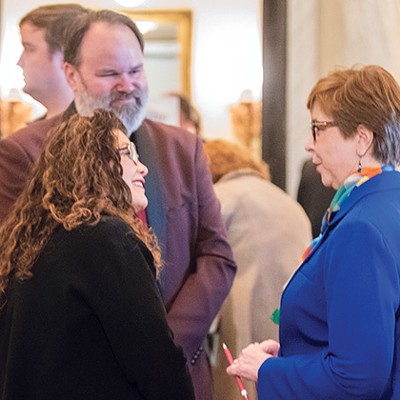With the biggest demolition of old buildings since urban renewal's heyday in the 1960s slated to begin in the near future, many wonder if the city's urban core is permanently losing its history one building at a time.
'Retaining that historic fabric'
Conserving integrity, authenticity
In July, the city's Board of Adjustment denied an appeal by the nonprofit Preservation Oklahoma (PO) to keep SandRidge Energy from knocking down five buildings on its downtown campus, the former home of Kerr-McGee. The plan was initially approved by the Downtown Design Review Committee to raze the buildings, one of which dates back to 1902.
"If this is the precedent that we're going to follow, we as a city have to decide if that's acceptable," said Marva Ellard, a downtown property owner and PO member. "I don't think it's acceptable for the downtown any of us have envisioned."
PO, a statewide partner with the National Trust for Historic Preservation, works jointly with the Oklahoma Historical Society and the State Historic Preservation Office.
Ellard feels like history is repeating itself as the city allows the energy company to knock down old buildings the same way urban renewal wiped out many old and historic structures beginning more than four decades ago.
'Retaining that historic fabric'
In the 1960s, the Oklahoma City Urban Renewal Authority (OCURA) sentenced buildings, like the Criterion Theater, Biltmore Hotel and other irreplaceable structures, to the wrecking ball in the name of eliminating blight and building new, modern structures where those once stood. Despite the authority's best-laid plans, many of those areas became gaping holes in the downtown landscape while others prospered, albeit sometimes years or decades later.
Leslie Batchelor, legal counsel for OCURA, said many also blame urban renewal for stripping downtown of irreplaceable buildings decades ago, but said several of those were given up willingly by their owners.
"People often don't recognize how many of those older buildings were voluntarily torn down by their owners," she said. "Or their owners were all too eager to sell their buildings to urban renewal because they didn't think they were worth anything."
SandRidge plans to tear down the buildings as part of its master plan for a corporate campus, stripping the block along Robinson Avenue of much of its density and urban street walls created by the existing buildings. Ellard is displeased that downtown will likely soon have another large, empty plaza like the areas surrounding the Chase Tower, officially called the Cotter Ranch Tower, and Leadership Square.
"Now we're going to have another one," she said. "Large empty plazas don't contribute to street life; they are the antithesis."
Time and again, SandRidge's architect, Rob Rogers, principal of New York-based Rogers Marvel Architects, has touted his firm's commitment to historic preservation projects, and repeatedly said the energy company did not make the decision lightly to knock down the old buildings. The plan does include a full renovation of the former Braniff Building on the corporate campus, which is listed on the National Register of Historic Places.
Representatives for PO, including Executive Director Katie McLaughlin Friddle, went to bat for the endangered buildings, citing the need to fully explore the historic integrity of each, and even offering to pay for it, so as not to strip downtown of some of its last remaining buildings from decades past.
"Oklahoma City has a really small historic core," Friddle said. "There's a lot of room in the city to be more modern and to add impressive buildings while still retaining that historic fabric downtown."
In an act of solidarity, SandRidge and PO released a joint statement Aug. 5 through the City of Oklahoma City that the preservation group would not pursue the demolition of the buildings in district court.
"We weren't trying to keep them out of downtown or trying to stop development downtown," Friddle said. "We're just trying to make sure it's balanced and the city's goals it set out for itself are being addressed."
Conserving integrity, authenticity
Anthony McDermid, principal with TAParchitecture, is a downtown business owner and resident who has advocated for keeping the area's historic integrity intact. He publicly opposed a proposed building for the Greater Oklahoma City Chamber in his corner of downtown because of what he cited as its setback on the land for which it was slated. McDermid said he was also involved in a project to turn some of the Kerr-McGee buildings into retail and residential space that fell apart when the company was acquired by Anadarko Petroleum before the properties were later purchased by SandRidge. The chamber building is on hold.
Guidelines are in place for the Downtown Design Review Committee and Board of Adjustment. Friddle was not pleased with the outcome, but did not feel either body acted inappropriately or overstepped their marching orders.
One document that can be used as a point of reference is the Building Conservation & Rehabilitation Guidelines for Oklahoma City, created by the Oklahoma City Planning Department and dated March 2010. Its stated intent is to clarify guidelines for retaining the city's urban character for building owners.
Language in the document states, "The city's early architectural resources are finite, and also vulnerable to inappropriate alteration and demolition." It further states that by retaining and rehabilitating historic buildings, it will conserve the integrity of architecture and the authenticity of the city.
Ellard is concerned with the direction downtown is headed if other well-financed entities can roll in and present plans for downtown that they expect to have approved.
"There has to be more input from planning staff and citizens on these big projects even when they are privately owned, because if they're downtown they affect a vast audience," she said. "At some point, it's not a downtown anymore; it's just a series of corporate campuses."
In light of the SandRidge decision, McDermid said he hoped it opened the eyes of many to be more vigilant and to speak up for historic buildings downtown.
"Regardless of your view on the merits of recent events, I believe the awareness and dialogue that took place during the SandRidge approval process showed we are maturing as a city and learning to value our built heritage and how it illuminates our history," he said. "These challenges are more like complex equations than arithmetic, but historic preservation is here to stay in Oklahoma City, and we should expect more advocacy for our built legacy as the historic building stock dwindles."
Those who opposed the demolition or wanted further review admit a healthy balance must exist between an entity proposing a project and community and local government input to create mutually beneficial projects. They also recognized that with too much input and oversight, projects might likely never get done or take years to reach a widespread consensus.
Friddle recognized that challenge and would like to see future projects that respect a developer's vision, while also staying true to the city, and to buildings that truly deserve to be saved.
"It's always a very hard thing for a city when someone comes in with a really exciting project, and they've invested the time, the money and energy into developing, and it's something that maybe you never even anticipated, and it's hard at that moment to step back and say, 'How does this apply, how does this not apply to what we had in mind for the city?'" she said.
Top photo Katie McLaughlin Friddle, Preservation Oklahoma's executive director, stands across the intersection of Robinson and Robert S. Kerr avenues from the square block of buildings surrounding the SandRidge tower.
Bottom photo Architect Rob Rogers, principal with Rogers Marvel Architects, shows a model of the proposed SandRidge Commons. Photos/Mark Hancock















